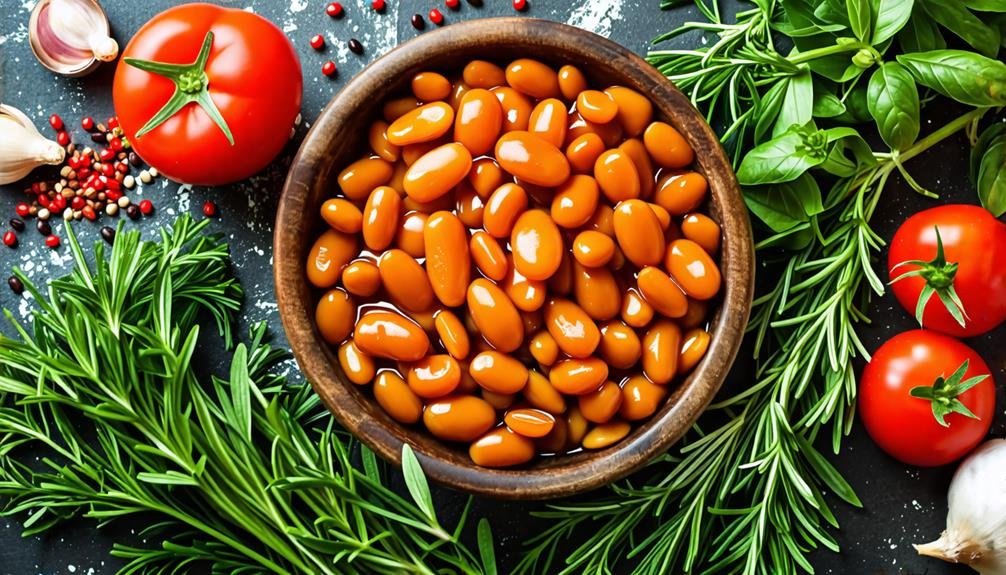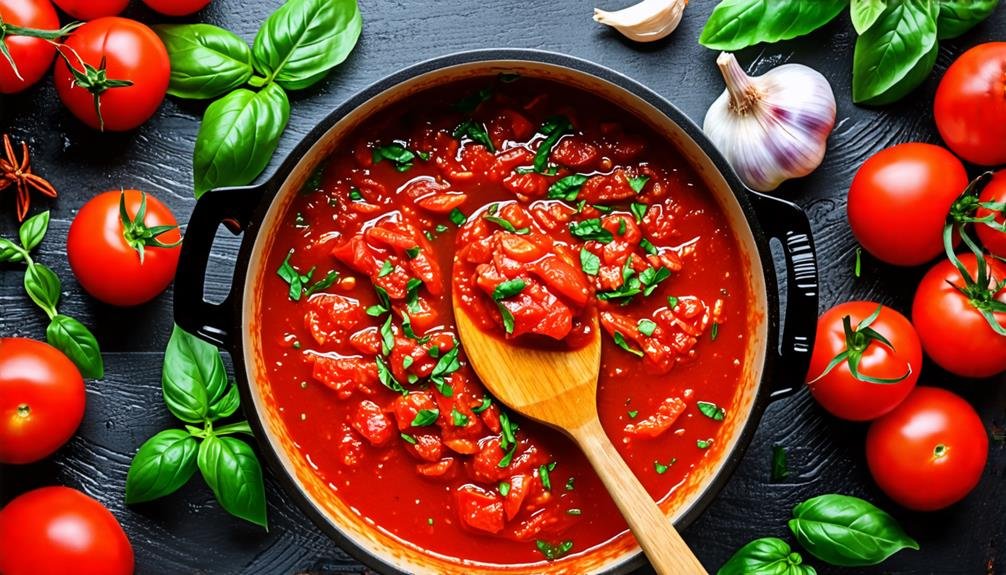Cooking canned green beans in bacon fat is a delightful way to enrich their flavor. Begin by draining and completely drying the beans; this will assist in achieving a satisfying crunch. In a hot skillet, sauté the beans in rendered bacon fat until they soak up that flavorful, smoky essence. The juxtaposition of tender beans with crunchy edges elevates this uncomplicated dish. Experiment with various bacon varieties for distinct flavors, like hickory or maplewood. A sprinkle of seasoning will additionally enrich their taste. You'll uncover methods that can transform your canned green beans into a standout side dish.
Understanding Canned Green Beans
Canned green beans, while convenient, often lack the fresh taste and crunchy texture of garden-fresh beans. For culinary enthusiasts who love to explore flavors, it's essential to understand these legumes. Canned green beans, typically preserved in salty water, can be bland and mushy, reducing their appeal as a tasty side dish. However, with a little creativity, you can elevate these beans by cooking them in bacon fat.
Bacon fat enhances the flavor profile of the legumes and introduces a rich, smoky essence that transforms ordinary green beans into a delicious side. By draining the canned green beans and sautéing them in bacon fat, you can achieve a pleasing crunch and infuse each bite with depth and complexity. This method invites culinary exploration, allowing you to choose from various bacon types—each offering a unique flavor that can elevate your dish.
Preparing canned green beans in this way not only revitalizes them but also celebrates the joy of cooking and flavor enhancement, making each meal more exciting and enjoyable. Embrace this culinary adventure and redefine your relationship with canned green beans.
Benefits of Bacon Fat
Incorporating bacon grease in your cooking not only enhances flavors but also provides numerous practical benefits, making it an essential element in any kitchen arsenal. One of the most attractive features of bacon grease is its extended shelf life. When stored properly in the refrigerator, it can last for three to six months, ensuring you have a tasty ingredient readily available for culinary inspiration.
Moreover, bacon grease is highly adaptable. It can be utilized in a variety of dishes, from sautéing fresh vegetables to adding depth to baked goods, giving each recipe a mouthwatering, savory kick. The unique smoky essence of bacon grease can elevate even the most basic meals, transforming ordinary ingredients into extraordinary dining experiences.
Additionally, the rendering process of bacon fat presents a fantastic opportunity for flavor exploration. Varieties of bacon, such as Smithfield's hickory or Oscar Mayer's applewood smoked, impart their own distinctive qualities into the grease, inviting you to experiment with a range of taste profiles. Lastly, bacon grease can be frozen for long-term storage, ensuring that this rich ingredient is always on hand. Embracing bacon grease unlocks a world of culinary creativity, encouraging freedom and innovation in your cooking adventures.
Preparing Green Beans for Cooking
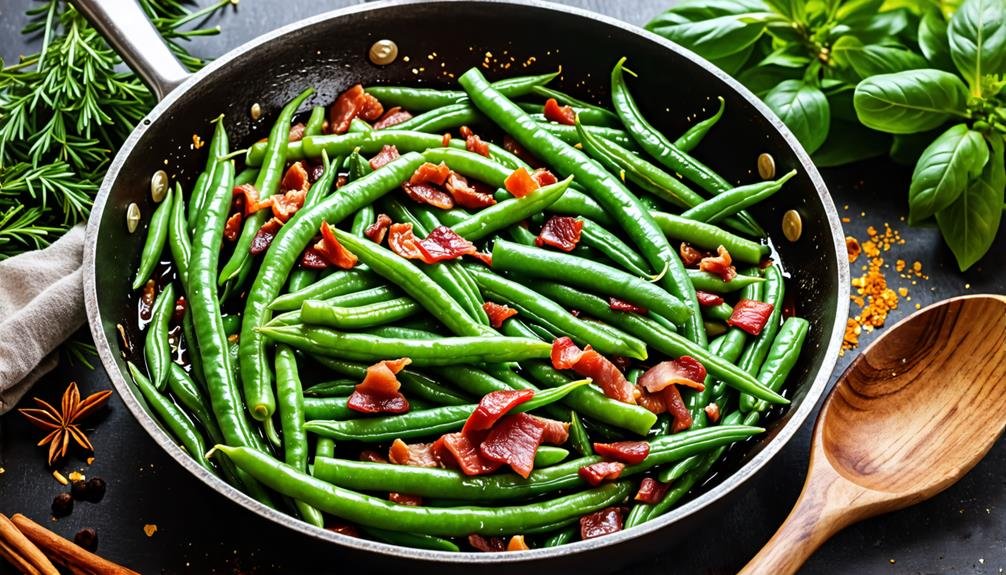
Preparing canned green beans for cooking is a crucial step to boost their flavor and texture. Start by selecting quality green beans; even canned varieties can be improved by choosing those with a vibrant color and minimal blemishes. Next, proper drying techniques will guarantee a seamless cooking process, preventing unwanted splattering and allowing the delicious bacon fat to coat each bean perfectly.
Selecting Quality Green Beans
When selecting green beans, focus on those that are crisp, rich in hue, and devoid of marks or drooping to ensure superb taste and texture in your meal. The quality of green beans significantly influences the overall flavor, and taking a moment to choose carefully can elevate your cooking experience.
Consider these essential characteristics when choosing green beans:
- Crispness: Seek beans that break easily; this indicates freshness.
- Hue: Pick beans that are a bright emerald green, indicating perfect ripeness.
- Size: Favor medium-length beans, as they often offer an optimal mix of tenderness and flavor.
Brands like Whole Foods and Trader Joe's often have high-quality selections, making your choice easier.
Proper Drying Techniques
To achieve the perfect texture and flavor, it's crucial to thoroughly dry canned green beans before cooking them in bacon fat. Excess moisture can lead to splattering, creating a mess and diminishing the desired crispiness. Start by draining the green beans in a colander, allowing the liquid to completely run off. Then, use a clean kitchen towel or paper towels to gently pat the beans dry, absorbing any remaining moisture. This simple step sets the stage for a delightful transformation.
Once the green beans are dry, they are ready to soak up the rich, smoky flavor of the bacon fat, enhancing their overall taste. Properly dried beans will sizzle and crisp beautifully in the rendered fat, providing a delightful contrast to their tender interior. As you embark on this culinary journey, remember that every detail matters, and drying the beans is a fundamental step toward achieving that perfect dish. Take a moment to incorporate this technique, and allow your taste buds to enjoy the delicious results that await!
Stovetop Cooking Method
The stovetop cooking technique enhances the flavor and texture of Del Monte canned green beans by utilizing the richness of bacon grease. This method infuses the beans with a savory, smoky essence and elevates their overall appeal. By choosing the stovetop, you gain control over the cooking process, allowing for a personalized touch to your meal.
- Swift Preparation: Stovetop techniques enable quick cooking, ideal for hectic schedules.
- Flavor Enhancement: Bacon grease seeps into the beans, delivering a rich taste that canned options often lack.
- Superior Texture: Searing the beans in bacon grease creates a delightful contrast between tenderness and a slight crunch.
For optimum results, begin by heating a generous amount of bacon grease in a skillet, then add your drained, pat-dried Del Monte green beans. Sauté them over medium-high heat, stirring occasionally until they are heated through and slightly browned. This straightforward yet effective technique transforms canned green beans into a delicious side dish that you'll desire!
Oven Roasting Technique
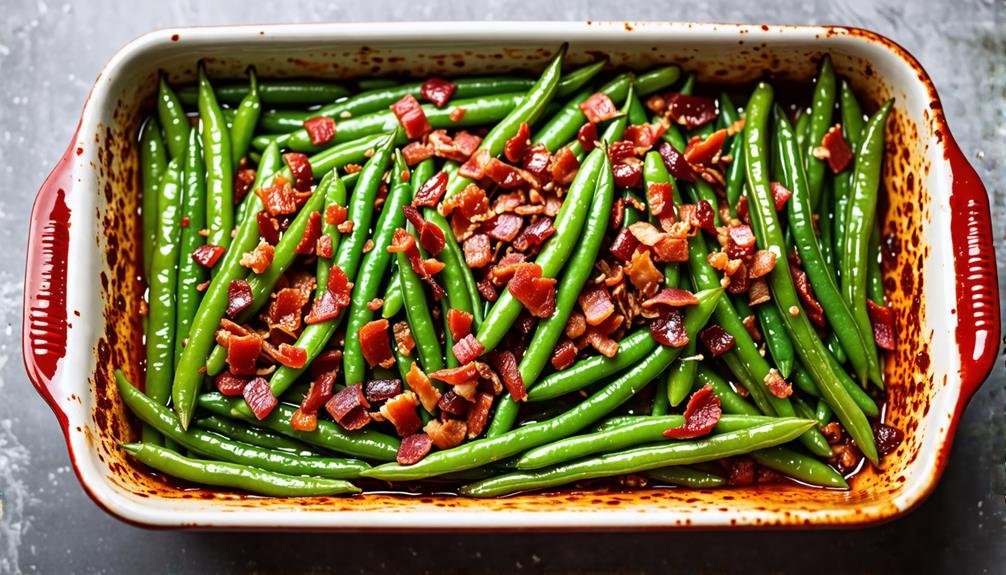
Oven roasting canned green beans in bacon fat transforms them into a flavorful side dish that rivals fresh vegetables. Start by preparing the green beans, ensuring they are patted dry to promote best crispiness. Set your oven to a sizzling 475°F and watch as the beans roast to perfection in just 20 minutes, creating a delightful contrast of tender insides and a crispy exterior.
Preparation of Green Beans
Roasting canned green beans in Smithfield bacon fat creates a savory and crispy side dish that elevates their flavor and texture. This technique transforms ordinary green beans into a delectable accompaniment that complements various meals.
- Flavor: The smoky richness of Smithfield bacon fat infuses the beans, making them incredibly delicious.
- Crunch: Oven roasting ensures a satisfying crispness that contrasts nicely with the tender insides.
- Ease: Minimal prep work allows for gourmet results with little effort.
To prepare your green beans, begin by preheating your oven and ensuring the beans are drained and dried with a paper towel. This crucial step helps avoid splattering during cooking. Next, evenly distribute the beans on a baking tray and drizzle them with melted Smithfield bacon fat. Toss them well to ensure each green bean is coated before placing them in the oven. The outcome is a dish that encapsulates both ease and flavor, giving you the opportunity to play with different seasonings and extra ingredients. Savor this delightful preparation as a quick and tasty addition to your cooking repertoire!
Roasting Time and Temperature
To achieve a delightful combination of crunch and tenderness in green beans, roast them at a high temperature of 475°F for around 20 minutes. This technique allows the green beans to develop a pleasing exterior while keeping their natural juiciness intact. The elevated heat effectively caramelizes the sugars, resulting in a robust flavor that pairs beautifully with the smoky essence of bacon fat.
Start by preheating your oven, and prepare a baking sheet lined with parchment paper for effortless cleanup. Spread the canned green beans, which have been thoroughly dried, in a single layer to ensure uniform roasting. Generously drizzle the savory bacon fat over them, making sure each bean is well-coated to enhance the taste.
After about 15 minutes, take a moment to evaluate your green beans; the aroma will be captivating! This is an ideal opportunity to check their crispiness, as oven performance can differ. If you desire a more pronounced crunch, let them roast for a few additional minutes. The final result will be a vivid side dish that elevates any meal, inviting you to savor the vibrant flavors.
Choosing the Right Bacon
Selecting the right bacon can greatly enhance the flavor of canned green beans cooked in bacon fat. The ideal bacon can elevate a simple side dish into a savory experience, adding depth and richness. When choosing your bacon, keep these factors in mind:
- Smoked or Unsalted: Smoked bacon, such as Applewood from Nueske's, imparts a robust, aromatic flavor. Unsalted options, like uncured bacon from Oscar Mayer, provide a milder taste that allows the green beans to shine.
- Cut Type: Thick-cut bacon offers a meaty texture, while regular cuts deliver a more delicate bite—pick based on your personal preference.
- Quality Counts: Brands like Boar's Head or Hormel provide high-quality bacon that enhances the overall taste; the impact is noticeable.
Exploring these different choices allows you to create a unique combination that suits your taste. The joy of cooking lies in discovering how each type of bacon can transform simple canned green beans into a dish that celebrates culinary creativity. Enjoy the process and savor the delightful variations that arise from your inventive selections!
Flavor Variations With Bacon Types
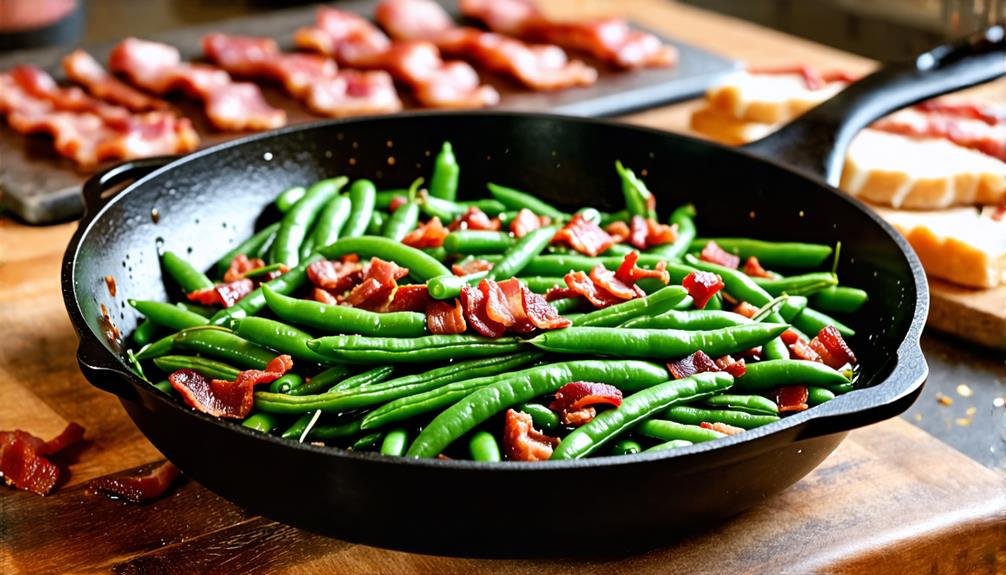
Exploring various bacon types can elevate the flavor profile of canned green beans, transforming a basic dish into a culinary masterpiece. Each bacon variety, such as Smithfield hickory, Oscar Mayer applewood, or Wright's maplewood smoked, brings a distinct smoky essence that can enhance your green beans.
The rich flavors of Smithfield hickory bacon create a comforting blend with the earthiness of the beans, producing a dish with remarkable depth. Meanwhile, Oscar Mayer applewood smoked bacon adds a subtly sweet note that harmonizes beautifully with the natural taste of green beans. For those who enjoy a touch of sweetness in their savory dishes, Wright's maplewood bacon offers a delightful twist, enriching the overall taste experience. Why not embark on a flavor journey? Experimenting with these bacon varieties will unveil a world of delicious possibilities.
Storing Leftover Bacon Fat
Storing leftover bacon fat properly is crucial to maintain its rich flavor and extend its usability. By using airtight containers and keeping it refrigerated, you can enjoy the savory goodness for up to six months. For those who want to keep it even longer, freezing bacon fat is a fantastic option, allowing you to savor that smoky essence whenever your culinary inspiration strikes!
Proper Storage Techniques
To ensure the shelf life and taste of leftover bacon grease, effective storage methods are crucial. Properly storing bacon grease not only maintains its savory essence but also allows you to utilize it for delicious recipes in the future. Here are essential recommendations for optimal storage:
- Strain the grease: Eliminate any remaining bacon bits prior to storage to avoid spoilage.
- Use a sealed container: Store the grease in a glass jar or a durable plastic tub to shield it from air and humidity.
- Refrigerate or freeze: Keep bacon grease in the refrigerator for 3-6 months, or choose to freeze it for long-term storage.
Shelf Life Considerations
Efficient storage practices can enhance the quality and longevity of remaining bacon grease, ensuring its availability for future culinary endeavors. To enjoy that rich, smoky flavor whenever desired, proper storage methods are essential. Start by straining the bacon fat through a fine mesh sieve to remove solid particles, which can spoil quickly. After straining, transfer the fat into a clean, airtight glass jar, as glass is non-reactive and seals tightly.
Storing your bacon fat in the refrigerator is highly recommended. When refrigerated, bacon fat can remain fresh for about 3 to 6 months. For culinary enthusiasts, having bacon grease on hand adds great flexibility to your cooking routine. Just ensure the lid is tightly sealed to protect it from air and moisture, which can hasten spoilage.
In moments of culinary inspiration, using leftover bacon fat can elevate various dishes, such as sautéed Green Giant canned green beans. With attentive care, you'll always have a flavorful ingredient ready to enhance your cooking! Enjoy exploring new flavors with your well-stored bacon grease.
Freezing for Longevity
Freezing leftover bacon grease is an excellent method for prolonging its freshness beyond standard refrigeration. This technique allows you to savor its rich flavor for an extended time. By storing this essential cooking fat, you can elevate your dishes whenever culinary creativity strikes. Here are some effective ways to freeze bacon grease:
- Strain before freezing: Eliminate any solid particles for a smooth consistency.
- Use airtight containers: Opt for small glass jars or freezer-safe bags to reduce air exposure.
- Label and date: Keeping track of when you froze the grease helps maintain an organized inventory.
With a bit of foresight, you can free your kitchen from the constraints of perishable bacon grease. Whenever you desire that savory richness in your meals, simply retrieve your frozen supply. From imparting a smoky flavor to sautéed vegetables to enriching hearty soups and stews, frozen bacon grease is a versatile kitchen staple. Embrace this opportunity to cook with enhanced flavor and let your culinary imagination flourish!
Enhancing Flavor and Texture
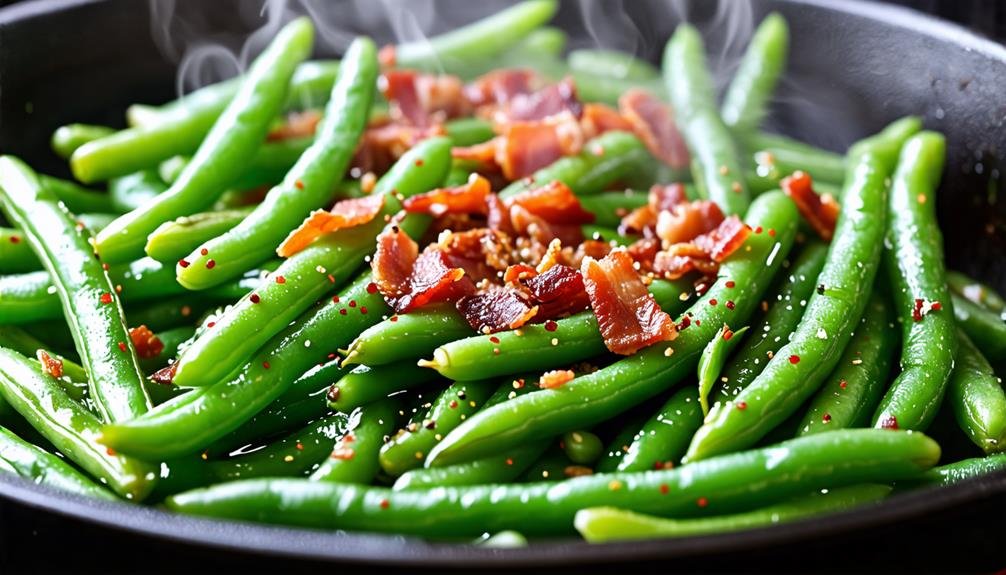
Cooking canned green beans in Smithfield bacon fat enhances their flavor and texture, turning a basic side dish into a rich, savory experience. The bacon fat enriches the beans' taste and adds a delightful crispiness that elevates every bite. When cooked, the fat infuses the beans with a smoky, savory essence, creating a depth of flavor often absent in canned varieties.
To achieve the best results, begin by patting the green beans dry to reduce splattering during cooking. Whether you opt to sauté or roast them, the secret is to allow the beans to absorb the bacon fat thoroughly. Oven-roasting excels in creating a crispy exterior while keeping the insides tender, ensuring a pleasing contrast in textures.
Additionally, experimenting with different bacon types—such as hickory-smoked, applewood-smoked, or maplewood-smoked from brands like Hormel—can introduce unique flavor profiles that make your dish memorable. Ultimately, cooking canned green beans in bacon fat provides a creative approach to enriching a humble vegetable, transforming it into a culinary delight that invites seconds.
Tips for Perfectly Cooked Green Beans
Achieving perfectly cooked green beans requires attention to detail in both preparation and cooking methods. To elevate your green bean experience, consider these essential tips:
- Thoroughly dry your green beans: Removing excess moisture ensures a delightful crispness.
- Choose your bacon wisely: Different types of bacon, such as Smithfield's hickory, Oscar Mayer's applewood, or Wright's maplewood, can significantly enhance your dish's flavor.
- Carefully monitor the cooking time: Whether using a stovetop or an oven, keep a close eye on your beans. Just a couple of minutes can make the difference between tender and mushy.


